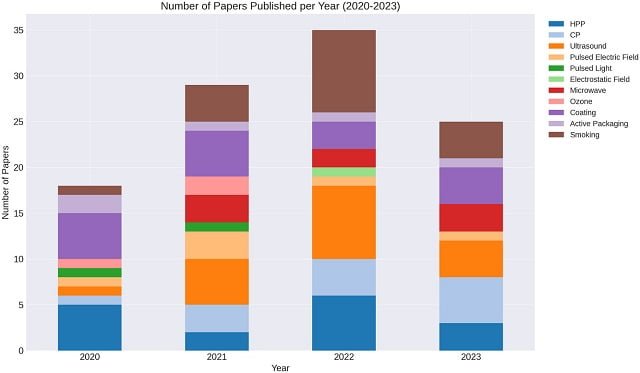Consumer environmental concerns have driven the quest for biodegradable packaging for fruits, meats, and fish, which are susceptible to rapid degradation. To address these challenges, research into the use of polymers has been promoted.
Imagine a coating made with nature’s generosity (salmon skin, algae, and a vibrant blue flower) that keeps your salmon fresh and delicious while combating unwanted bacteria and harmful oxidation.
This is not just a culinary dream; it’s the forefront of food science as researchers have developed a dual-layer biopolymer coating with these remarkable properties.
Scientists from the University of Agriculture in Cracow, the Jagiellonian University Medical College, the Polish Academy of Sciences, the Jan Długosz University in Częstochowa, and the Cracow University of Economics created coatings based on natural ingredients obtained from by-products of the food industry and the butterfly pea flower (Clitoria ternatea), thus reducing solid waste from the fishing and aquaculture industry.
Innovative Coating
This innovative coating features two layers, each with its superpower:
- Inner layer: A blend of salmon skin gelatin and furcellaran, an algae known for its gel-forming properties, infused with an extract of the Clitoria ternatea flower. This beautiful blue flower, also known as butterfly pea, exhibits significant antibacterial activity, keeping bacteria that cause deterioration at bay.
- Outer layer: This layer is a pure duo of gelatin and furcellaran, providing a protective barrier against external factors like moisture loss and oxygen exposure, further extending the shelf life of your salmon.
The scientists evaluated the resulting coatings for their physicochemical, mechanical, antibacterial, and antioxidant properties.
Inhibition of Bacterial Growth
Tests showed that hydrogels containing Clitoria ternatea extract not only inhibited the growth of troublesome gram-positive bacteria but also exhibited impressive antioxidant activity, comparable to a well-known antioxidant standard.
And the best part?
These coatings are biodegradable wonders that are nature-friendly. They behave like true gels under stress, maintaining their shape while remaining flexible. Their flow behavior even mimics that of shear-thinned fluids, meaning they become thinner when spread, making them easier to apply and more uniform.
Stay Always Informed
Join our communities to instantly receive the most important news, reports, and analysis from the aquaculture industry.
Real-World Application
Now, let’s talk about the real-world impact. When used on salmon fillets, these active coatings proved their worth by significantly slowing down microbial growth during the refrigerated storage period. This translates to fresher and tastier salmon for a longer duration, reducing food waste and preserving valuable resources.
While the research focused on salmon, the potential of these innovative coatings goes far beyond. Further studies with other food products could usher in a new era of sustainable and effective food preservation, all thanks to the power of nature and a touch of blue flower magic.
Conclusions
“Successful production of double-layer coatings based on furcellaran, salmon gelatin, and an aqueous extract from dried Clitoria ternatea flowers was achieved to obtain a packaging solution that eliminates the drying stage, significantly reducing costs and streamlining the film production process,” conclude the scientists.
The main findings of the study can be summarized as follows:
- Double-layer biopolymer coatings made from fish skin, seaweed, and Clitoria ternatea flower extract offer a natural and effective way to preserve food.
- These coatings exhibit antibacterial and antioxidant properties, extending shelf life and reducing deterioration.
- Their gel-like behavior and easy application make them ideal for various food products.
The scientists recommend further research to identify broader applications of these sustainable and innovative coatings in other aquaculture products.
Contact
Wiktoria Grzebieniarz
Department of Chemistry
University of Agriculture
Balicka 122, PL-30-149 Kraków, Poland
Email: wiktoria.grzebieniarz@urk.edu.pl
Reference
Wiktoria Grzebieniarz, Joanna Tkaczewska, Lesław Juszczak, Nikola Nowak, Paweł Krzyściak, Paulina Guzik, Mirosław Kasprzak, Małgorzata Zimowska, Ewelina Jamróz, Design of active double-layer gel coatings based on furcellaran-gelatin and aqueous butterfly pea (Clitoria ternatea) flower extract for prolonging the shelf-life of salmon (Salmo salar). Progress in Organic Coatings, Volume 186, 2024, 107945, ISSN 0300-9440, https://doi.org/10.1016/j.porgcoat.2023.107945.
Editor at the digital magazine AquaHoy. He holds a degree in Aquaculture Biology from the National University of Santa (UNS) and a Master’s degree in Science and Innovation Management from the Polytechnic University of Valencia, with postgraduate diplomas in Business Innovation and Innovation Management. He possesses extensive experience in the aquaculture and fisheries sector, having led the Fisheries Innovation Unit of the National Program for Innovation in Fisheries and Aquaculture (PNIPA). He has served as a senior consultant in technology watch, an innovation project formulator and advisor, and a lecturer at UNS. He is a member of the Peruvian College of Biologists and was recognized by the World Aquaculture Society (WAS) in 2016 for his contribution to aquaculture.




